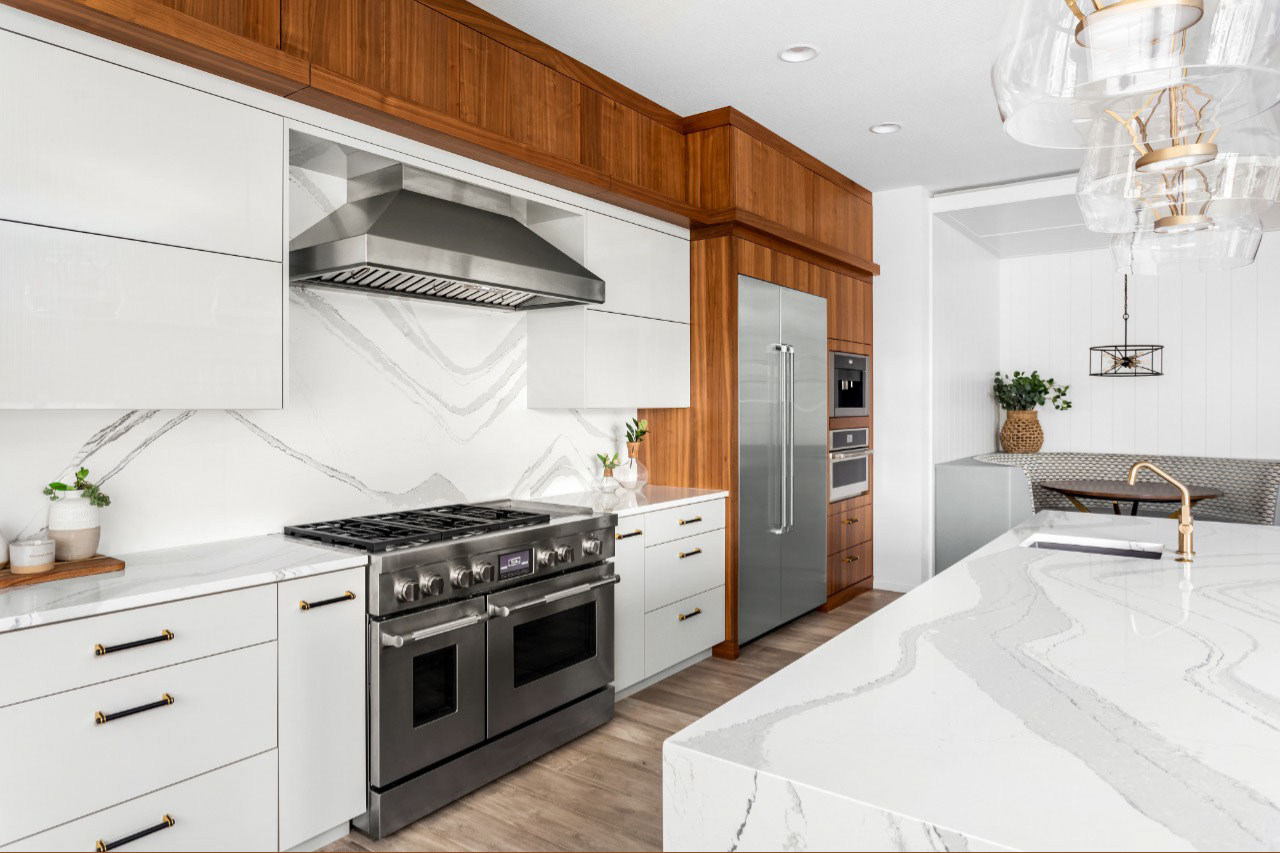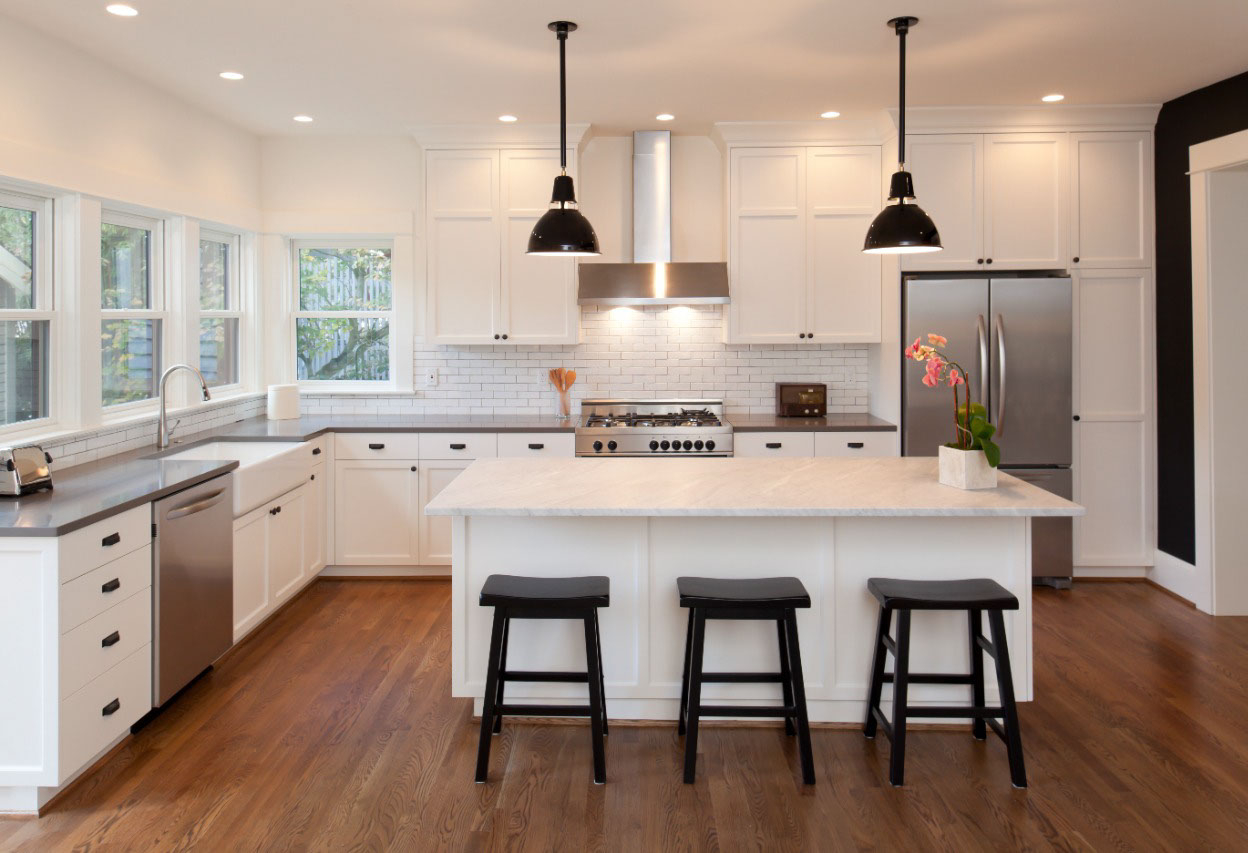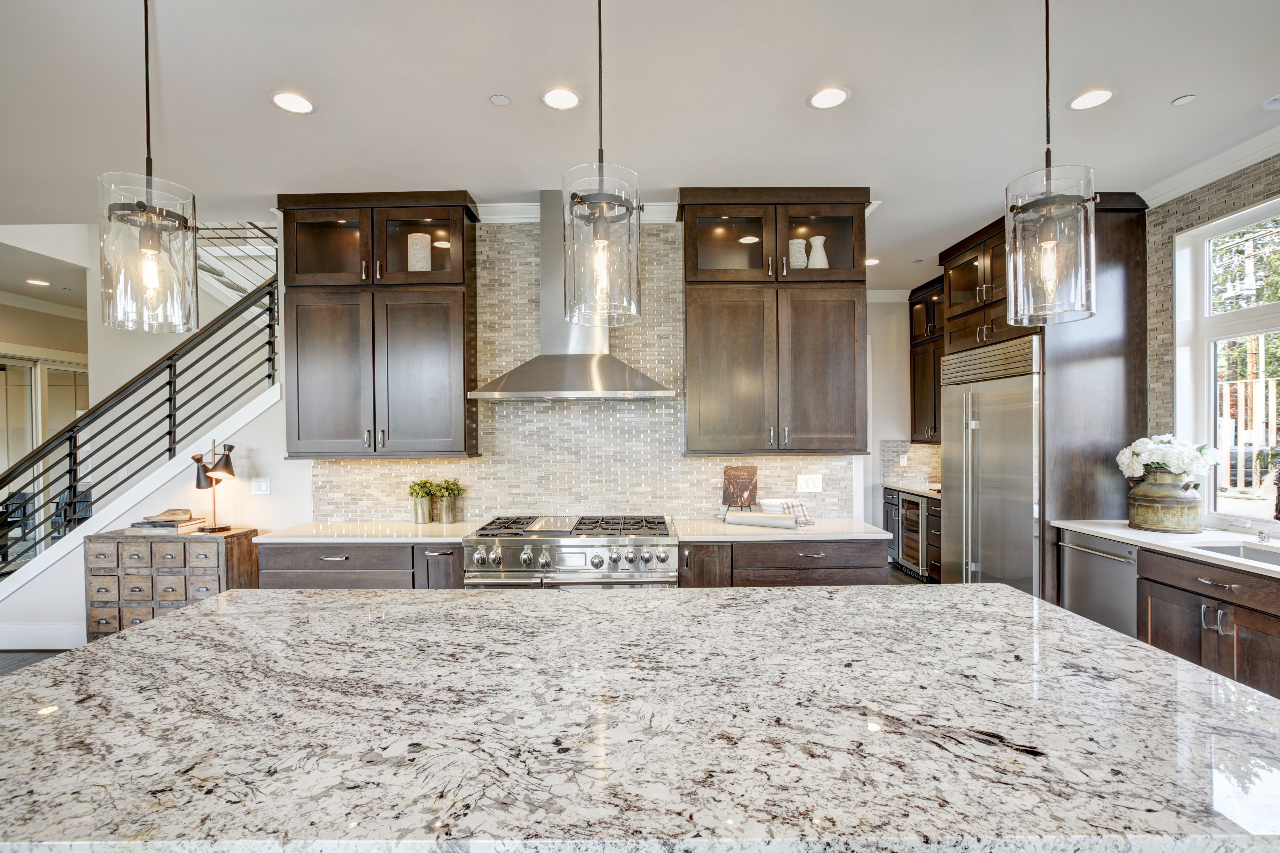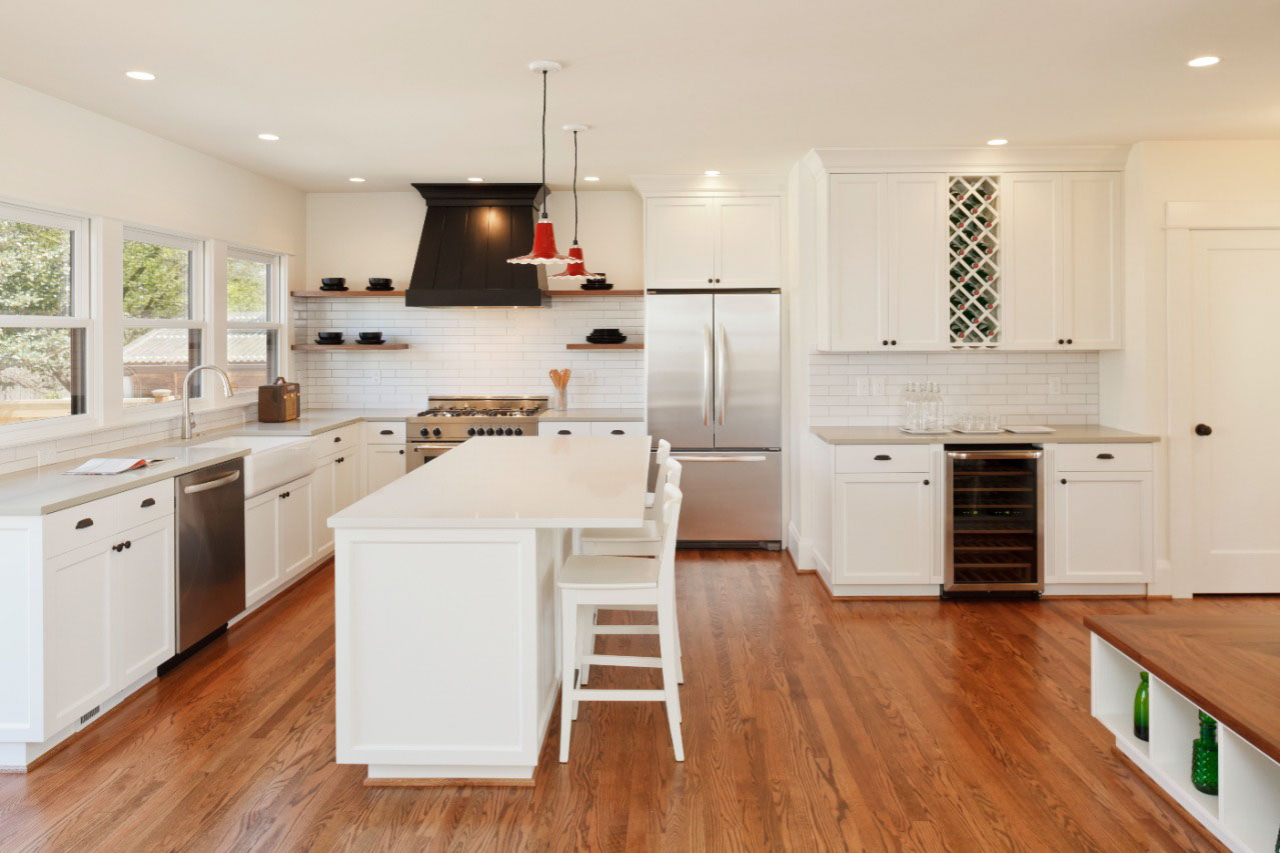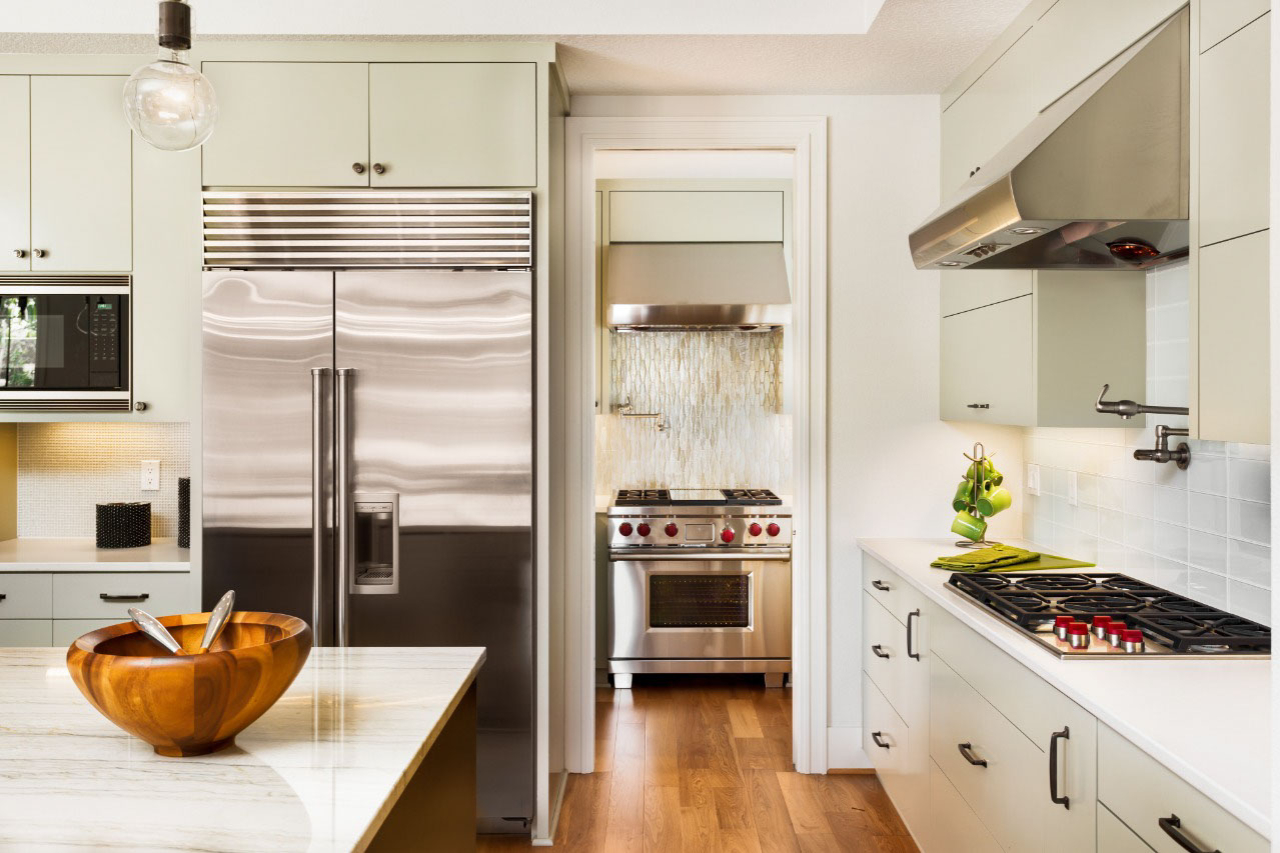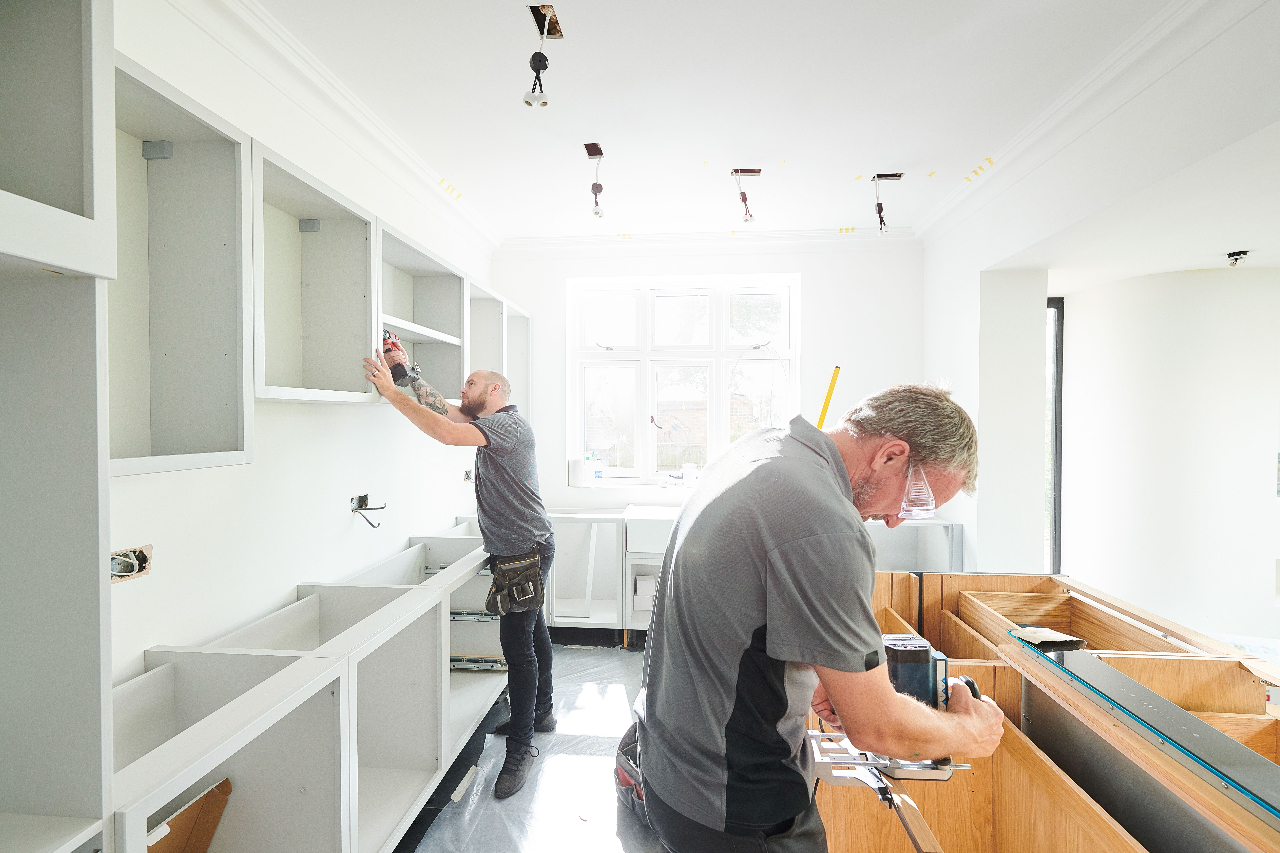How Much Does a Kitchen Remodel Cost? [2023 Data]
Typical Range:
$14,592 - $41,533
Typical Range:
$14,592 - $41,533
Cost data is based on actual project costs as reported by 12,898 HomeAdvisor members. Embed this data
.
.
.
.
.
.
.
.
.
.
.
.
.
.
.
.
.
.
.
.
.
.
.
.
.
.
.
.
.
.
•
•
•
•
Updated December 2, 2022
Reviewed by Robert Tschudi, Expert Home Building and Remodeling Contributor.The average kitchen remodel costs $26,972, or roughly $150 per square foot, with typical kitchen remodel prices running between $14,592 and $41,533. Major kitchen renovations may cost around $70,000, while the most upscale kitchen remodel cost could surpass $130,000. The total expense varies depending on the space size, the quality of the materials, and whether you change the room's layout.
A smaller project costing between $10,000 and $15,000 may include painting walls, refacing cabinets, upgrading the sink, and installing a tile backsplash. A $30,000-plus renovation may include installing custom cabinets, hardwood floors, granite counters, and high-end appliances. While kitchen remodels can be expensive and complicated, decommissioning your cooking space for several weeks, a well-done kitchen renovation can increase your home's value.
To determine how much to remodel a kitchen, use our kitchen remodel cost estimator below and review our cost breakdown by scope, size, labor, and features.
2023 Notice: Material Prices Are Surging
Demand for siding and other building materials has grown over the past year. And as a result, manufacturers are increasing materials prices. Prices have gone up 5% to 10% this year, and many parts of the country are experiencing long delivery times. If you're planning a building project, we recommend starting as early as possible in the season, preparing for potential price fluctuations, and allowing extra time to order materials.
Let's calculate cost data for you. Where are you located?
Where are you located?
| National Average | $26,972 |
| Typical Range | $14,592 - $41,533 |
| Low End - High End | $3,500 - $65,500 |
Cost data is based on actual project costs as reported by 12,898 HomeAdvisor members.
The extent of your kitchen renovation or remodel can significantly impact the overall price. But for the average kitchen remodel, you can count on a few key cost factors: cabinets, additional materials, design and labor, appliances, and countertops and backsplashes.
See the estimated average percentages your factors contribute to your total cost.
The largest cost of any true kitchen remodel is new cabinets. Custom cabinets are the most expensive; you can save money by purchasing stock or semi-custom. For even greater savings, you can reface or refinish existing cabinets.
Other kitchen remodel material costs include drywall, sinks and faucets, flooring, lighting fixtures, hardware for cabinets and drawers, paint, doors, and windows. These costs can vary depending on the degree of your renovation.
Small kitchen renovations, like installing a new backsplash or new flooring, may qualify as a DIY project, but most projects require a licensed plumber or electrician. For a large remodel, hire a general contractor to coordinate all the moving pieces of the project. You may also need to pay for an interior designer or architect at the start of the project.
If your kitchen upgrade includes new appliances, you’ll need to budget for everything from a refrigerator and oven to a dishwasher and microwave. Energy-efficient, smart appliances are the most expensive. At the very least, it’s a good idea to ensure all new appliances match the aesthetic of your remodeled kitchen.
Countertops can vary significantly in final cost depending on the material you choose. Quartz and wood countertops are the most expensive. Countertop costs for large kitchens with ample counter space will inherently cost more than a small kitchen with minimal counters. Backsplashes can add a functional and fashionable pop to walls and may be an easy weekend DIY project.
On average, a homeowner spends $26,000 on a kitchen remodel, but costs can vary depending on the extent of the renovation. The good news: You can remodel your kitchen on almost any budget.
Determining how much it is to remodel a kitchen and how much it is to renovate a kitchen are two different calculations, though contractors may use the terms "kitchen remodel" and "kitchen renovation" interchangeably.
So what's the difference between a kitchen remodel and a renovation? A kitchen renovation typically involves keeping the kitchen layout the same while updating countertops, paint, appliances, and flooring. A kitchen remodel implies a larger project that might include gutting part or all of the kitchen and changing the overall layout and flow. As such, the average kitchen remodel cost is higher than the average kitchen renovation cost.
While the average kitchen remodel costs roughly $26,000, you can spend a lot less with a targeted budget—and a lot more for a total kitchen makeover. Most remodels will fall somewhere in between.
You can still have the kitchen of your dreams with a smaller budget of around $5,000 to $10,000. When planning out your kitchen renovation costs, consider the following to save a little extra money:
Pass on custom cabinets: Cabinets take up almost 30% of the budget for kitchen remodels. Save with stock products or reface or refinish your existing cabinets instead of replacing them. Refacing cabinets costs around $4,270–$10,000; refinishing cabinets costs around $1,830–$4,160.
DIY where possible: See where you can do some of the installation and replacement yourself.
Remodel in stages: Break up the projects into smaller phases so you only have to save for one thing at a time.
Only do necessary updates: Upgrade the materials and appliances that truly need updating. Refinishing appliances costs about $150–$550. If your budget allows, consider replacing appliances to increase visual appeal and your return on investment (ROI).
“We often recommend one or two 'showstopper' appliances, such as a high-end range or refrigerator,” says Robert Tschudi, Angi Expert Review Board member and a general contractor in Raleigh, NC. “These tend to elevate the whole kitchen.”
Minor kitchen remodels cost around $10,000 to $20,000. At this price range, you can touch most or all parts of the kitchen, but you might be looking at lower-end materials. With this budget, you can likely upgrade appliances, put on a fresh coat of paint, install new faucets, and even put in a backsplash.
If your kitchen remodel budget falls between $20,000 and $70,000, you have more than enough for major upgrades using high-quality materials. Projects might include adding built-in energy-efficient appliances, custom cabinets, a commercial-style range oven, a drink or coffee station, and a cooktop or seating island. You can install new flooring and light fixtures and add elegant touches, like high-end hardware for the cabinets and drawers.
Gutting the kitchen and implementing a new layout comes with additional costs for plumbing, electrical, walls, and flooring. Total kitchen overhauls can cost from $30,000 to $80,000 or more. If you’re gutting a kitchen and implementing the most upscale materials, you’ll pay around $100,000 to $130,000.
For total makeovers and layout changes, you’ll need to budget for the following:
The labor required to knock down walls and gut your kitchen
Plumbing costs for new pipes and hookups
Electrical rewiring costs for appliances and lighting
“The number one kitchen remodel request involves removing a wall to create an ‘open-concept’ layout,” says Tschudi. “If that wall is a load-bearing wall, removing it will be expensive and reduce the overall stability of the house. On the other hand, if the wall isn’t structural, the cost to remove it is very reasonable. If you’re going to remove a wall—structural or not—be sure to engage with a licensed structural engineer.”
If you’re unsure about some of the options above, consider the questions below to determine how to budget your kitchen remodel:
What kind of cook am I? Different cooks have different needs. If you frequently host, consider space for two ovens.
Will my kitchen only be used for cooking? Consider making room for dining, entertaining, and the everyday.
How long will I live in this house? If you plan on moving soon, stick to design choices with universal appeal.
Who uses the kitchen? Think about lowering workspaces and making appliances accessible for those who need them.
What are my must-haves? Think about what features you can’t live without and when you’d be happy to go with a lower-cost alternative.
Where you live can impact overall kitchen remodel costs, largely due to differences in material and labor prices. The table below shows the average cost range of kitchen remodels by major city:
| U.S. City | Average Cost Range to Remodel a Kitchen |
|---|---|
| Boston | $15,580 – $40,300 |
| Chicago | $12,980 – $34,280 |
| Cleveland | $10,300 – $27,080 |
| Dallas | $12,330 – $33,950 |
| San Francisco Bay Area, CA | $25,600 – $61,100 |
| Las Vegas | $20,380 – $41,800 |
| Los Angeles | $29,800 – $51,480 |
| Miami | $11,900 – $32,180 |
| Newark, NJ | $13,600 – $37,630 |
| Northern Virginia/Washington, D.C. | $15,230 – $36,830 |
| Phoenix | $12,530 – $33,130 |
| Portland, OR | $13,780 – $36,130 |
| San Diego | $23,600 – $48,350 |
| San Francisco | $25,450 – $61,400 |
| San Jose, CA | $34,050 – $58,430 |
| Seattle | $18,950 – $50,300 |
| Springfield, MA | $10,800 – $40,400 |
Several factors can impact your total kitchen remodel cost, including the size of your kitchen, labor, the quality of materials and appliances, and the extent of the renovations.
The average kitchen remodel cost is approximately $150 per square foot, including materials, appliances, and labor. In the most basic sense, the larger your kitchen, the larger the cost. Using the average square footage estimate, the table below shows how a moderate kitchen remodel cost can vary by size:
| Kitchen Size in Sq. Ft. | Average Kitchen Remodel Cost |
|---|---|
| 75 | $11,250 |
| 100 | $15,000 |
| 150 | $22,500 |
| 200 | $30,000 |
Professional kitchen designers cost around $65 to $250 per hour. The typical kitchen designer accounts for roughly 3%of your renovation budget.
If you get advice or an in-home consultation from a materials and design store, expect a flat fee ranging from $100 to $800. However, some homeowners report paying around $4,400 to $25,000 for certified professionals and independent services. At this rate, you might expect services such as the following:
3D renderings
Material and color selection
Coordination with contractors and suppliers
Start-to-finish support and management
Depending on the extent of your renovation, labor may cost from $3,500 to $6,000 for a minor or major remodel. Larger kitchen makeovers requiring extensive plumbing, electrical, and carpentry can cost much more. No matter the extent, it’s fair to calculate roughly18%of your total renovation costs as labor costs.
For larger projects, especially total guts and redesigns, you’d likely benefit from hiring a local kitchen remodeling contractor who can subcontract all the various players involved in the remodel.
On the flip side, minor budget-friendly renovations (including a fresh coat of paint or installing a new dishwasher) might qualify as a DIY project if you’re up to the task.
Kitchen cabinet installation costs an average of $1,860 to $9,430, with the products ranging from $100 to $1,200 per linear foot or more. Cabinets, especially custom-made ones, are the most expensive parts of a kitchen renovation. Using stock cabinets keeps prices down, but cabinets often serve as the kitchen's curb appeal, meaning higher-quality cabinets may help you sell your home.
The table below breaks down the difference in cabinet prices between stock, semi-custom, and completely custom per linear foot. These prices include the cost of installation. For budget-friendly or minor remodels, you can reface or refinish your existing cabinets for a fraction of the cost.
| Cabinet Type | Average Cost Range per Lin. Ft. Including Installation |
|---|---|
| Stock | $100 – $300 |
| Semi-custom | $150 – $650 |
| Custom | $500 – $1,200 or more |
Kitchens require a large number of handles, knobs, and pulls for the cabinets and drawers. The more cabinets and drawers your new kitchen utilizes, the more hardware you’ll need to purchase.
Beyond quantity, the color, style, and material can impact the final cost. On the low end, kitchen hardware can cost less than $1 per unit, but the highest-quality knobs and pulls can cost as much as $500. Most homeowners will pay around $2 to $3 per handle or knob. You can save money by buying in bulk, with packs ranging from six to 1,000 units.
Installing countertops costs around $1,860 to $4,340, though this price will fluctuate depending on the material and measurements. Countertops play a significant role in the look and usability of your space. Choose the materials based on what looks and functions best.
Within each category of materials, the price depends on quality. Seamless materials, such as Corian and granite, tend to be more durable but are generally more expensive. Formica and concrete are less costly but add less value. Tile is attractive but requires more maintenance and regular grout cleaning.
Review common countertop materials, their costs, and their benefits in the table below:
| Countertop Material | Average Cost Range | Features |
|---|---|---|
| Bamboo | $2,000 – $3,000 | Eco-friendly; easy to clean; susceptible to scratches and burns |
| Concrete | $2,100 – $4,000 | Durable; heat- and stain-resistant; requires regular maintenance |
| Corian | $2,200 – $5,000 | Durable; many colors and styles; stain-resistant; easy to maintain and clean |
| Granite | $2,250 – $4,500 | Durable; scratch- and heat-resistant; porous and requires sealing |
| Laminate | $790 – $1,630 | Heat-, stain-, and scratch-resistant; easy to clean; inexpensive |
| Marble | $2,000 – $5,000 | Durable; long-lasting; heat-resistant; susceptible to staining and scratching |
| Paper composite | $2,500 – $6,000 | Durable; easy to clean; susceptible to scratches and stains |
| Quartz | $1,500 – $12,000 | Many colors and styles; stain-resistant; doesn’t chip or scratch easily; easy to clean |
| Recycled glass | $1,800 – $3,750 | Durable; heat- and stain-resistant; easy to clean; susceptible to chipping and scratching |
| Soapstone | $2,700 – $4,200 | Stain- and heat-resistant; extremely susceptible to scratching and etching |
| Solid surface | $1,950 – $4,920 | Nonporous; scratch-resistant; susceptible to heat and staining |
| Stainless steel | $4,000 – $11,250 | Durable; heat- and stain-resistant; susceptible to scratches |
| Tile | $480 – $1,950 | Inexpensive; susceptible to chipping and scratching; requires maintenance and cleaning |
| Wood | $600 – $12,000 | Durable; long life span; expands and contracts like flooring; withstands burns and scratches |
Installing kitchen appliances costs around $120 to $280 per appliance for installation. Energy-efficient EnergyStar appliances can offer great savings over time, and higher-end built-in appliances greatly appeal to buyers when you put your house on the market.
Kitchen appliances typically include the refrigerator and freezer, oven and stove, microwave, and dishwasher. For each, you can choose from the following:
Budget-friendly freestanding appliances: $200–$1,000
High-end freestanding appliances: $1,000–$5,000+
Custom built-in appliances: $1,000–$10,000+
EnergyStar appliances range between $300 and $3,000 and are available at every budget level.
Flooring installation costs about $1,520 to $4,700. The largest cost factors include the room's square footage and the chosen material. Vinyl and linoleum flooring are the most affordable but are more easily damaged and don't last as long. Tile, granite, and wood are more expensive but will add value, elegance, and durability to your kitchen. The more expensive flooring sometimes proves to be more challenging to maintain.
Kitchens can be volatile workstations. Damage from stains, grease, heat, and moisture is common. If you can't keep up with the cleaning and maintenance, the more expensive flooring might not be the best for you.
If you’re stuck between hardwood and laminate, check out our comparison guide for hardwood flooring versus laminate flooring. Or review the table below for kitchen flooring options:
| Floor Material | Average Cost Range | Features |
|---|---|---|
| Bamboo | $1,500 – $15,000 | Eco-friendly; low maintenance; low-cost; scratches easily |
| Ceramic tile | $900 – $3,020 | Durable; various colors; susceptible to cracking and chipping |
| Concrete | $1,540 – $3,840 | Easy to maintain; long-lasting; moisture-resistant |
| Cork | $500 – $1,400 | Eco-friendly; mildew- and stain-resistant; requires regular maintenance |
| Laminate | $1,470 – $4,620 | Inexpensive; various styles; requires regular maintenance |
| Linoleum | $950 – $3,760 | Eco-friendly; stain-resistant; requires regular maintenance |
| Marble | $2,500 – $5,000 | Durable; long-lasting when properly maintained; stains and scratches easily |
| Natural stone | $920 – $3,050 | Durable; expensive; absorbs stains |
| Slate | $7,200 – $32,000 | Durable; stain-resistant; low maintenance; fewer style varieties |
| Terrazzo | $1,800 – $7,000 | Durable; long-lasting; easy to clean; expensive |
| Wood | $2,480 – $6,800 | Durable; wear-resistant; requires regular maintenance |
| Vinyl | $950 – $3,760 | Inexpensive; durable; can emit VOCs |
Rearranging appliances for a larger remodel entails relocating water supply lines, drains, and sewage lines. This often involves getting new pipes, with installing pipes costing about $1,180. This also means spending more on labor and, in some cases, hiring a plumber near you.
You might also need a permit from the city. Kitchen remodel permits cost from $500 to $1,500.
Part of your overall plumbing costs may include installing a faucet or even an entirely new sink. Installing a faucet costs around $160 to $360. If you don’t need to change the plumbing layout, installing a sink costs about $220 to $630.
An easy way to update your kitchen on a budget is installing a new backsplash, which is something homeowners may be able to tackle themselves. If you're not handy around the house, hiring a local tile installer will save you the hassle.
Whether part of a small kitchen upgrade or a complete kitchen remodel, hiring a contractor to install a tile backsplash costs between $590 and $1,320. If you're attempting to DIY, you'll need to buy tiles, mortar, and a few tools. For example, subway tiles cost between $7 and $13 per square foot.
Electricians cost on average $50 to $100 per hour. It’s best to do electrical work during the tear-out process. At this point, determine whether you need to upgrade your electrical output to accommodate a new refrigerator or oven. The cost to upgrade an electrical panel averages about $1,220.
You may also need to move outlets and fixtures to accommodate a new layout or replace outdated outlets. The cost to install an outlet adds about $220 to your project total. Hire a local electrician to handle the process safely. Electrical work typically makes up 5% of the average kitchen remodel cost.
“Many kitchen remodels require an upgrade to the electrical system,” says Tschudi. “To comply with code, some appliances require dedicated circuits, and all outlets on counters need to have ground-fault circuit interrupter systems, which trip the instant water and electricity come in contact to prevent electrocution.”
Moving a gas line costs around $270 to $880. Unless you're planning to move your oven and stove cooktop to an entirely different place in the room, you should be able to avoid this expense. The process involves moving and running additional gas lines, upending flooring, and knocking out walls. It also requires a permit for handling natural gas lines. If you plan to move a vented range, you'll need to install a new venting system.
If you currently have an electric oven but want to upgrade to a gas range oven, you'll need to budget between $130 and $2,000 for the conversion plus the cost of the new appliance. The work may involve hiring a local gas line plumber and an electrician. Gas ovens allow you to control the temperature when cooking and baking more easily, they heat up and cool off faster, and they generally lead to a reduction in utility bills.
Budget-friendly remodels can involve painting walls. The cost of painting a kitchen ranges from $300 to $750.
When completing a kitchen makeover, you might knock down and rebuild some walls. Removing a non-load-bearing wall costs as little as $300 while taking down a load-bearing wall costs up to $3,000. To improve safety, you can also opt for fire- and moisture-resistant drywall when doing a kitchen remodel. Current drywall prices range from $12 to $20 per panel.
Most ceiling work will entail painting or drywall work if installing new light fixtures.
Larger kitchen remodels and total kitchen makeovers may involve creating new openings for interior doors and even exterior doors and windows. Here’s how these break down:
Interior door installation cost: $360–$1,170 per door
Exterior door installation cost: $510–$1,790 per door
Window installation cost: $300–$1,200 per window
Remember to factor in light fixture installation costs when building your budget. Upscale kitchen remodels might include accent lighting, like a pendant light over the sink. Recessed lighting is a popular option for kitchens. In general, recessed lighting costs around $300 per fixture.
A larger kitchen remodel might involve expanding into a larger space. For example, you might repurpose an old dining area to create more cabinet and counter space or knock down walls to give yourself a more open floor plan. Expanding into an existing room will lead to more extensive costs for wall removal, cabinetry, electrical, and plumbing.
Some homeowners even build an addition to house a larger kitchen. Kitchen home additions cost between $20,000 and $90,000.
The National Kitchen & Bath Association (NKBA) provides a kitchen renovation budget breakdown that helps homeowners visualize where they can expect their budget to go. In the table, we’ve used a $30,000 budget so you can see how the percentages may play out.
| Kitchen Renovation Element | Budget Percentage | Average Cost |
|---|---|---|
| Cabinets | 28% | $8,400 |
| Labor and installation | 18% | $5,400 |
| Appliances | 15% | $4,500 |
| Countertops and backsplashes | 11% | $3,300 |
| Flooring | 7% | $2,100 |
| Lighting | 5% | $1,500 |
| Painting and drywall | 5% | $1,500 |
| Doors and windows | 4% | $1,200 |
| Plumbing | 3% | $900 |
| Design | 3% | $900 |
| Other | 1% | $300 |
Homeowners remodel kitchens for several reasons. If you need to know if now is a good time to take on the cost of a kitchen remodel, evaluate your kitchen condition and budget before moving forward. During your evaluation, watch out for these common signs that it's time to remodel your kitchen.
Cabinets can last for several decades, but they’re a high-use feature of kitchens and will eventually start to fall apart (e.g., loose handles and hinges, splintering wood, broken doors, etc.). If your cabinets are beyond saving, it may be time to buy new ones.
Keep in mind that kitchen styles come and go. Upgrading kitchen cabinets to match the newest trend in interior design doesn't make the best financial sense. You can keep up with changing trends more easily by painting or refinishing existing cabinets.
Floors take a lot of wear and tear. And in a kitchen where you’re regularly pacing between the stove, sink, counters, and fridge, floors tend to have a shorter life span. If you notice your floor is warped or peeling, it may be time to hire a local flooring repair contractor or install new ones entirely.
If you plan a kitchen remodel down the road, move it up and pair the project with a flooring installation.
Over the years, countertops can separate from the cabinet bases and the wall, which could lead to food crumbs getting stuck in hard-to-reach places. Eventually, you won’t be able to prepare food on a shifting countertop. If your countertop has seen better days, it’s time to upgrade—and you might want to consider replacing the cabinets beneath the countertops in one fell swoop.
If your appliances are several decades old, they may be inefficient, driving up your gas and electric bills while taking longer to cook. Old, inefficient ovens can even be dangerous. Newer appliances, like smart fridges with ice makers, may also make your life easier.
Evaluate whether your appliances are due for an upgrade. If installing several new appliances, try to match the style for a seamless aesthetic. You can even take this opportunity to reface, refinish, or replace cabinets or install new countertops to make the new aesthetic more cohesive.
With sinks, dishwashers, and refrigerators, kitchens are likely culprits for water leaks. While the cost to repair a leaky pipe is roughly $500, you might spend a lot more on water damage that goes unchecked. If water has warped your floors and damaged your walls and cabinets, it may be time for a complete kitchen remodel. Budget between $1,300 and $5,520 in basic water damage restoration costs.
Consider remodeling your kitchen if your pantry is overflowing and your drawers are stuffed full of kitchen supplies. In mocking up a new layout, you can prioritize cabinet and drawer space to accommodate your family's needs. If a full kitchen renovation cost is out of your price range, consider smaller changes you can make to improve storage.
If your dishwasher can’t open all the way without hitting the island or your fridge is far away from your countertops, you might be dealing with a lot of unnecessary hassle. Work with an architect near you to design a kitchen layout that better serves your needs.
Knowing how much to renovate a kitchen is important before starting the project, but the high cost of kitchen remodeling can be alarming. However, don't let it sway you. Remodeling a kitchen has multiple benefits, including financial ones.
When you sell your house, you may earn about 60% of what you spend on the kitchen remodel. And while you'll spend more than you make, you can enjoy that kitchen for a while before selling—potentially at a faster rate.
If you have an inefficient kitchen layout, you might waste a lot of time or have a miserable time cooking. If cooking is your hobby or you need an efficient kitchen to accommodate your busy schedule or large family, a remodel may be in order.
Investing in energy-efficient appliances is another way to recuperate your money. Because they yield lower utility bills, efficient appliances can pay for themselves over time. Plus, they’re better for the environment.
If you live in an older home and have for a long time, the kitchen may no longer be up to today's safety standards. Not only can you not sell a house with a kitchen with code violations, but it's also unsafe for you and your family to cook in. Licensed contractors can complete your kitchen remodel completely up to code.
A new kitchen can make you feel a certain way. While we can't quantify how much an aesthetically pleasing kitchen improves your life, you might find happiness and peace in a more modern-looking kitchen.
Kitchen remodels are expensive, so how can you save money? We recommend doing the following:
Make a budget: Having a set amount of money you’re willing to spend and sharing that with your contractor can help them set realistic expectations about what you can accomplish.
Avoid high-quality materials: You’ll save a lot of money by opting for functional lighting and stock cabinetry. Apply these principles with every purchase, from hardware to appliances.
DIY when possible: Don’t try to move a gas line, knock down a wall, or install new plumbing yourself, but some elements of a kitchen renovation are manageable on your own. Take the weekend to install a backsplash, lay down new flooring, or paint the walls.
A basic kitchen remodel on a budget—like a fresh coat of paint, a new refrigerator, and even a refinished cabinet or two—is possible for DIY-ers. But any moderate to extensive kitchen renovation should be left to professionals, especially where plumbing and electrical work are involved. Licensed contractors can help you with permitting and code, and they’ll install materials correctly for a better final appearance and greater ROI when you go to sell.
Because a kitchen remodel costs tens of thousands of dollars, get quotes from several local plumbers, local electricians, or even local kitchen remodeling contractors for big projects. Go with the best price as long as the company has great reviews.
Larger kitchen remodels may involve multiple types of contractors. You can simplify it on your end by hiring a single kitchen remodeler who'll then subcontract all the individual pieces of the project. When going this route, make sure you thoroughly consider the candidates.
When vetting potential contractors for a kitchen remodel, do the following:
Ask to see a portfolio of their previous work.
Determine their schedule and the timetable for completing your specific project.
Ask what warranties they offer.
Ask what insurance they carry.
Ask if you’ll be able to use the kitchen during the remodel.
See which subcontractors they would work with on your project.
While it can be tempting to go with the lowest estimate, always thoroughly read reviews of each contractor online.
While a complete kitchen makeover and any major kitchen remodel involving plumbing and electrical work should be left to the professionals, it’s possible to save money by DIY-ing smaller kitchen remodels and renovations—or at least tackling certain elements yourself, like painting the walls, installing a backsplash, or installing appliances.
How much money can you save by doing it yourself? The typical DIY kitchen remodel costs around $9,000 to $30,000, while the average kitchen remodel costs around $13,380 to $38,420 with professional labor.
Cabinets are the most expensive part of a kitchen remodel and account for roughly 28% of the total cost. For a complete kitchen remodel, mid-range stock cabinetry costs about $10,000 to $20,000, while high-end cabinetry costs about $20,000 or more. Expect to pay around $6,000 on top of that for cabinet installation.
Any upgrade to your kitchen can add value to your home and help you sell it faster, but there are a few specific things you can do to your kitchen to really drive up the value. The following remodeling projects generally add the most value to your kitchen:
New cabinets
Additional storage
Kitchen island
New countertops
Upgraded (and efficient) appliances
High-quality flooring
The average kitchen remodel takes six to 10 weeks, but it can take even longer, depending on the size of the kitchen, the product availability, and subcontractors’ schedules. The initial planning and design phase takes an additional four weeks.
It costs an average of $37,130 to renovate both the kitchen and the bathroom, with bathroom remodels costing around $11,230 of the total. Many remodeling contractors are licensed to perform both projects with the help of subcontractors, so you can often hire one contractor for all the work. A general contractor will subcontract out licensed pros for plumbing, electrical, and mechanical or HVAC.
Gutting a kitchen costs around $500 to $3,000, depending on regulations in your area, the size of your space, and what you need to be demolished or removed. Your city and county may have regulations surrounding proper waste disposal and materials that require extra steps and labor.
There may also be requirements around getting an interior demolition permit in addition to your building permit. Plus, if you want to preserve some of the existing materials, you’ll pay more in labor for more careful removal.
Remodeling a mobile home kitchen could be as little as $3,000 and as much as $25,000, depending on the size of the kitchen, the quality of materials you use, and the extent of the renovation.
Before you remodel a mobile home, it's best to consult a contractor who'll ensure your changes comply with the U.S. Department of Housing Urban Development (HUD) Code.

